The source is of a green dragon rendering. My question is how to get the clip distances working on it? Also, the textures are not appearing as the expected output. Any ideas what can be modified in the source code to render the program as expected?
Update: With the excellent help and superb answers of Rabbid76 the clip distance is working and texture loading is working! Thank You.
Bonus example: clipdistance_torus_package.zip a clip distance example with a torus and textures!
Expected output:
Files to run: clipdistance_dragon.zip
#!/usr/bin/python3
import sys
import time
import ctypes
fullscreen = True
sys.path.append("./shared")
from sbmloader import SBMObject # location of sbm file format loader
from ktxloader import KTXObject
from sbmath import m3dDegToRad, m3dRadToDeg, m3dTranslateMatrix44, m3dRotationMatrix44, m3dMultiply, m3dOrtho, m3dPerspective, rotation_matrix, translate, m3dScaleMatrix44, \
scale, m3dLookAt, normalize
try:
from OpenGL.GLUT import *
from OpenGL.GL import *
from OpenGL.GLU import *
from OpenGL.raw.GL.ARB.vertex_array_object import glGenVertexArrays, glBindVertexArray
except:
print ('''
ERROR: PyOpenGL not installed properly.
''')
sys.exit()
import numpy as np
from math import cos, sin
identityMatrix = [1,0,0,0, 0,1,0,0, 0,0,1,0, 0,0,0,1]
myobject = SBMObject()
render_program = GLuint(0)
paused = False
class uniforms:
proj_matrix = GLint(0)
mv_matrix = GLint(0)
clip_plane = GLint(0)
clip_sphere = GLint(0)
uniform = uniforms()
def shader_load(filename, shader_type):
result = GLuint(0)
with open ( filename, "rb") as data:
result = glCreateShader(shader_type)
glShaderSource(result, data.read() )
glCompileShader(result)
if not glGetShaderiv(result, GL_COMPILE_STATUS):
print( 'compile error:' )
print( glGetShaderInfoLog(result) )
return result
def link_from_shaders(shaders, shader_count, delete_shaders, check_errors=False):
program = GLuint(0)
program = glCreateProgram()
for i in range(0, shader_count):
glAttachShader(program, shaders[i])
glLinkProgram(program)
if not glGetProgramiv(program, GL_LINK_STATUS):
print( 'link error:' )
print( glGetProgramInfoLog(program) )
if (delete_shaders):
for i in range(0, shader_count):
glDeleteShader(shaders[i])
return program
def load_shaders():
global render_program
global uniform
if (render_program):
glDeleteProgram(render_program);
shaders = [
shader_load("render.vs.glsl", GL_VERTEX_SHADER),
shader_load("render.fs.glsl", GL_FRAGMENT_SHADER)
]
render_program = link_from_shaders(shaders, 2, True)
uniform.proj_matrix = glGetUniformLocation(render_program, "proj_matrix");
uniform.mv_matrix = glGetUniformLocation(render_program, "mv_matrix");
uniform.clip_plane = glGetUniformLocation(render_program, "clip_plane");
uniform.clip_sphere = glGetUniformLocation(render_program, "clip_sphere");
tex_dragon=None
class Scene:
def __init__(self, width, height):
global myobject, tex_dragon
myobject.load("dragon.sbm");
load_shaders()
ktxobj = KTXObject()
tex_dragon = ktxobj.ktx_load("pattern1.ktx")
def display(self):
global paused
currentTime = time.time()
black = [ 0.0, 0.0, 0.0, 0.0 ]
one = 1.0
last_time = 0.0
total_time = 0.0
if (not paused):
total_time += (currentTime - last_time)
last_time = currentTime
f = total_time
glClearBufferfv(GL_COLOR, 0, black)
glClearBufferfv(GL_DEPTH, 0, one)
glUseProgram(render_program)
proj_matrix = (GLfloat * 16)(*identityMatrix)
proj_matrix = m3dPerspective(m3dDegToRad(50.0), float(self.width) / float(self.height), 0.1, 1000.0)
T1 = (GLfloat * 16)(*identityMatrix)
m3dTranslateMatrix44(T1, 0.0, 0.0, -15.0)
RY = (GLfloat * 16)(*identityMatrix)
m3dRotationMatrix44(RY, f * 0.34, 0.0, 1.0, 0.0)
T2 = (GLfloat * 16)(*identityMatrix)
m3dTranslateMatrix44(T2, 0.0, -4.0, 0.0)
mv_matrix = (GLfloat * 16)(*identityMatrix)
mv_matrix = m3dMultiply(T1, m3dMultiply(RY, T2))
RX = (GLfloat * 16)(*identityMatrix)
m3dRotationMatrix44(RX, f * 6.0, 1.0, 0.0, 0.0)
RY = (GLfloat * 16)(*identityMatrix)
m3dRotationMatrix44(RY, f * 7.3, 0.0, 1.0, 0.0)
plane_matrix = (GLfloat * 16)(*identityMatrix)
plane_matrix = m3dMultiply(RX , RY )
plane = plane_matrix[0:4]
plane[3] = 0
plane = normalize(plane)
clip_sphere = [sin(f * 0.7) * 3.0, cos(f * 1.9) * 3.0, sin(f * 0.1) * 3.0, cos(f * 1.7) + 2.5]
glUniformMatrix4fv(uniform.proj_matrix, 1, GL_FALSE, proj_matrix)
glUniformMatrix4fv(uniform.mv_matrix, 1, GL_FALSE, mv_matrix)
glUniform4fv(uniform.clip_plane, 1, plane)
glUniform4fv(uniform.clip_sphere, 1, clip_sphere)
glEnable(GL_DEPTH_TEST)
glEnable(GL_CLIP_DISTANCE0)
glEnable(GL_CLIP_DISTANCE1)
glActiveTexture(GL_TEXTURE0)
glBindTexture(GL_TEXTURE_2D, tex_dragon)
myobject.render()
glutSwapBuffers()
def reshape(self, width, height):
self.width = width
self.height = height
def keyboard(self, key, x, y ):
global fullscreen
global paused
print ('key:' , key)
if key == b'\x1b': # ESC
sys.exit()
elif key == b'f' or key == b'F': #fullscreen toggle
if (fullscreen == True):
glutReshapeWindow(512, 512)
glutPositionWindow(int((1360/2)-(512/2)), int((768/2)-(512/2)))
fullscreen = False
else:
glutFullScreen()
fullscreen = True
elif key == b'p' or key == b'P':
paused = not paused
elif key == b'r' or key == b'R':
pass
print('done')
def init(self):
pass
def timer(self, blah):
glutPostRedisplay()
glutTimerFunc( int(1/60), self.timer, 0)
time.sleep(1/60.0)
if __name__ == '__main__':
start = time.time()
glutInit()
glutInitDisplayMode(GLUT_RGBA | GLUT_DOUBLE | GLUT_DEPTH)
glutInitWindowSize(512, 512)
w1 = glutCreateWindow('OpenGL SuperBible - Clip Distance')
glutInitWindowPosition(int((1360/2)-(512/2)), int((768/2)-(512/2)))
fullscreen = False
#glutFullScreen()
scene = Scene(512,512)
glutReshapeFunc(scene.reshape)
glutDisplayFunc(scene.display)
glutKeyboardFunc(scene.keyboard)
glutIdleFunc(scene.display)
#glutTimerFunc( int(1/60), scene.timer, 0)
scene.init()
glutMainLoop()
ported into python from clipdistance.cpp , source of sbmobject.cpp just in case sbmloader.py is in question for the texture issue.

